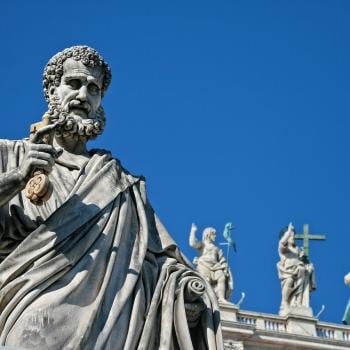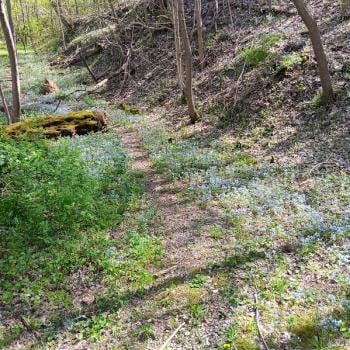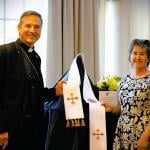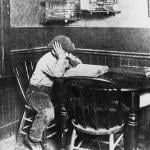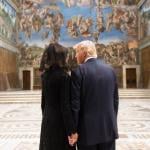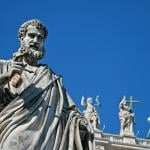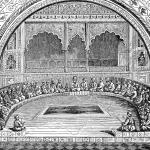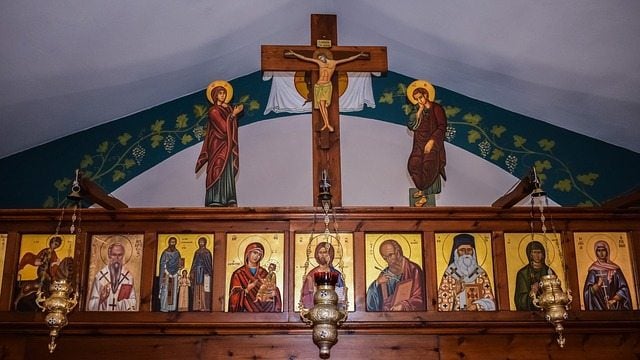
It has been a whole year since I’ve been to an Eastern Divine Liturgy.
We ended up across the river in West Virginia this Sunday– not at our old Eastern church, though. I miss that more than anything in the world, but we still have no way to get there. We were at a Latin church in a different part of that city: a large building with a pink marble interior, neither very beautiful nor very ugly, as close to a generic American Latin Catholic church as appearances can get.
This is my least functioning time of year, as far as fibromyalgia goes. I was grateful to get to a liturgy at all, even though our ride arrived late. I hobbled into a back pew using my cane for balance while they were singing the Gloria.
“The children may come to the front for the Liturgy of the Word,” said the cantor.
My daughter shyly stayed in her seat, but many children in the congregation stepped forward. The priest welcomed them; he ushered them to a front pew in a way that was not at all patronizing.
“Jesus is always present here, so we genuflect on the right knee!” he prompted.
He seemed pleased to see them in his church.
The kindness in his voice startled me.
Kindness is something that is in short supply in the Ohio Valley.
I’ve grown to find grace and beauty here in Northern Appalachia. There are plenty of both to be found. But that doesn’t mean that I can’t see its faults– and the greatest fault I have found in Northern Appalachia is its unkindness. Northern Appalachia fairly celebrates unkindness. Brutality is valorized as a sign of strength here. We are a stern, cruel, bullying culture. Nurses laugh at the misfortunes of patients in the hospitals and shame them for crying. Parents hit their children and think it will teach respect. Bus drivers mock and humiliate passengers. And the churches around here– I have heard stories that would put you off church for life. Some of them I’ve told and some I still don’t dare. There are people here who think they’re serving God, if they can drive their brothers and sisters away from Him. It happens all the time.
The liturgy went on from there. There was nothing wrong with the homily, though nothing in it struck me. There was nothing wrong with the music, though it wasn’t remarkable. I sang along.
A few times, while I was kneeling, I was so tired that my head flopped forward and rested on the pew in front of me, but the person sitting inches from my forehead didn’t react with alarm.
There was a man sitting next to her with two little granddaughters clamoring on his lap. The look on his face, whenever I caught sight of it, was bliss and admiration rather than annoyance. He wasn’t only happy his grandchildren were at church with him– he seemed awed by their presence. If I could truly believe that God the Father looked at me that way, I wouldn’t be afraid to come to Him as I so often am.
People at this particular church tend to chatter and whisper among themselves more often than is quite appropriate. It’s the kind of thing that used to annoy me in the extreme, but somehow it didn’t just then. The grandfather whispered to his granddaughters, from time to time. The woman inches from my tired head interjected too, talking to all three of them. Someone– I think he was the usher– put a friendly greeting hand on the shoulder of the woman immediately behind me. She started in surprise, and he apologized. She laughed and greeted him in something louder than a whisper when she realized he was someone she knew.
Between my tiredness and the whispering, I was distracted from the prayers the priest was saying. That’s why you’re not supposed to chatter among yourselves in liturgy even in whispers, after all. But today it seemed harmless. I was watching God the Father admire His children. I was listening to someone who was shocked to find she wasn’t alone and then overjoyed that the Presence with her was Someone she loved. This, too, is liturgy.
People at this church hold hands during the Our Father, which I dislike.
I dislike this whole liturgy, more than a little. I want to to be at an Eastern church, with incense and a glorious iconostasis, chanting Hospodi Pomiluj. I am so sick of all this– sick of the Latin Rite, sick of the Ohio Valley, sick to death of the brutality that permeates the culture and presents itself as a Godly thing. Liturgical customs and regions of the country where you don’t feel you belong are harmless. The cruelty, though– that’s against Christ. And Christians who practice cruelty against one another and call it righteousness are anti-Christ in the very strictest sense.
Still, no one here was acting unkind, and that was breathtakingly beautiful. I almost reached for the hand of the person next to me– almost. I wish I’d dared.
As I hobbled up to Communion, there were people all around, smiling at each other, whispering, casually pleasant in a way that would have annoyed me once. I would have called it irreverent. Now, it seemed anything but irreverent. It was beautiful. People were happy to see one another. They loved each other. It looked like Heaven come down to earth.
People are the iconostasis for one another.
If you went into an Eastern Christian church and didn’t know any better, you’d think the iconostasis was a wall of icons separating the congregation from the sanctuary. In fact it’s the opposite. The iconostasis is the wall of icons revealing Heaven to the people. Icons are windows to Heaven. If they weren’t between the congregation and the priest, we wouldn’t be able to see Heaven so clearly. We’d think it was just a priest in funny vestments, touching bread and muttering words. But we see the images and remember Who is really present to us. And then the doors of the iconostasis open and Christ walks out and says “Approach with fear of God and with Faith,” and we come to Him. If for some reason the priest refused to open the doors and say those words; if he just stood back there, clutching the chalice to Himself, and never went out, we couldn’t receive Christ, but that would not be the fault of the iconostasis. The iconostasis is a door to Heaven, not a wall to keep us out.
People are also doors. We are also icons. We, together, the community of Christians in a church, are an iconostasis for one another and for anyone who comes to us.
This is reality, something believers have known in some fashion since the Book of Genesis was written down. In His image, we are created. We are the image of God for one another. We, people, human beings, are a wall of icons. We are what people confront when they walk into a church. We stand between them and the Holy of Holies, and we are meant to reveal Who is hidden in the tabernacle to them, to one another. The doors are supposed to open, and Christ is supposed to come out, through us, to feed His people.
Or, we can be cruel. We can choose to do things that Christ would not do while wearing His image, and blaspheme Him in that way. We can keep the doors closed so no one will approach. And, so often, we do.
Standing in that church, in line for Communion, at that most generic of Western churches without a painted icon to be seen, accustomed to cruelty everywhere and shocked at its sudden absence– I found myself part of a jumbled and noisy iconostasis revealing Heaven to one another. I, myself, was an icon. And I was praying, silently, by myself, “O Lord, I believe and profess that you are Christ, the Son of the living God.”
“Blood of Christ,” said the extraordinary minister.
“Amen,” I said.
That prayer is so much less beautiful than “Servant of God, Mary, receives the Body and Blood of Christ, for the remission of her sins and for everlasting life.” But Christ is the same.
I went and knelt among the wall of icons– I, myself, an icon.








